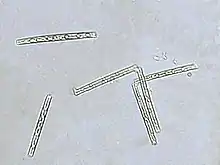Thalassionema nitzschioides
Thalassionema nitzschioides is a type of phytoplankton belonging to the pennate diatom group.[1]
| Thalassionema nitzschioides | |
|---|---|
 | |
| Scientific classification | |
| Domain: | |
| (unranked): | |
| Superphylum: | |
| Class: | |
| Order: | Thalassionematales |
| Family: | Thalassionemataceae |
| Genus: | |
| Species: | T. nitzschioides |
| Binomial name | |
| Thalassionema nitzschioides Grunow, 1862 | |
Characteristics
- Length (apical axis): 10 - 110 μm
- Width: 2 - 4 μm
- Height: 3 - 8 μm
- Marginal areolae: 10 - 12 in 10 μm
Thalassionema nitzschioides are a yellow brown color.[2]
Their cells are straight and linear and they connect to form zigzagging chains. The cells are rectangular shaped, with rounded ends, and the cells are connected at the ends of each other.[3] “Sometimes an apical spine is present and the marginal ornamentation is visible as ribs.”[4]
Global Distribution
Thalassionema nitzschioides can be found all over the world except in polar regions along shallow coastal ocean waters. They occur all year round with higher concentrations in the spring and are usually found in high concentrations.[5][6] Salinity and temperature conditions for optimal growth rate are 12-38 PPT and 15 °C respectively.[7]
References
- "Thalassionema nitzschioides". Integrated Taxonomic Information System. Retrieved 26 October 2015.
- "The University of British Columbia." EOS. Web. 21 Oct. 2015.
- Marshall,Harold G. 1986. Identification Manual for Phytoplankton of the United States Atlantic Coast. National Technical Information Service. U.S. Department of Commerce.
- Hoppenrath, Mona, and Malte Chter. Marine Phytoplankton: Selected Microphytoplankton Species from the North Sea around Helgoland and Sylt. Stuttgart: E. Schweizerbart'sche Verlagsbuchh., 2009. Print.
- Hoppenrath, Mona, and Malte Chter. Marine Phytoplankton: Selected Microphytoplankton Species from the North Sea around Helgoland and Sylt. Stuttgart: E. Schweizerbart'sche Verlagsbuchh., 2009. Print.
- Marshall,Harold G. 1986. Identification Manual for Phytoplankton of the United States Atlantic Coast. National Technical Information Service. U.S. Department of Commerce.
- "The University of British Columbia." EOS. Web. 21 Oct. 2015.